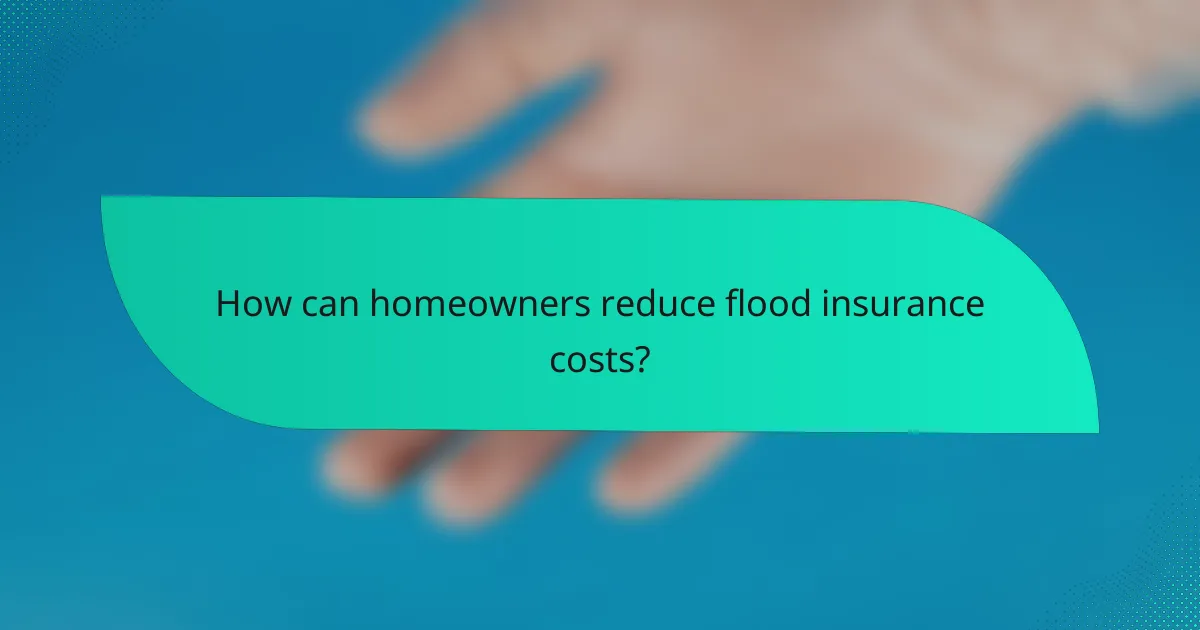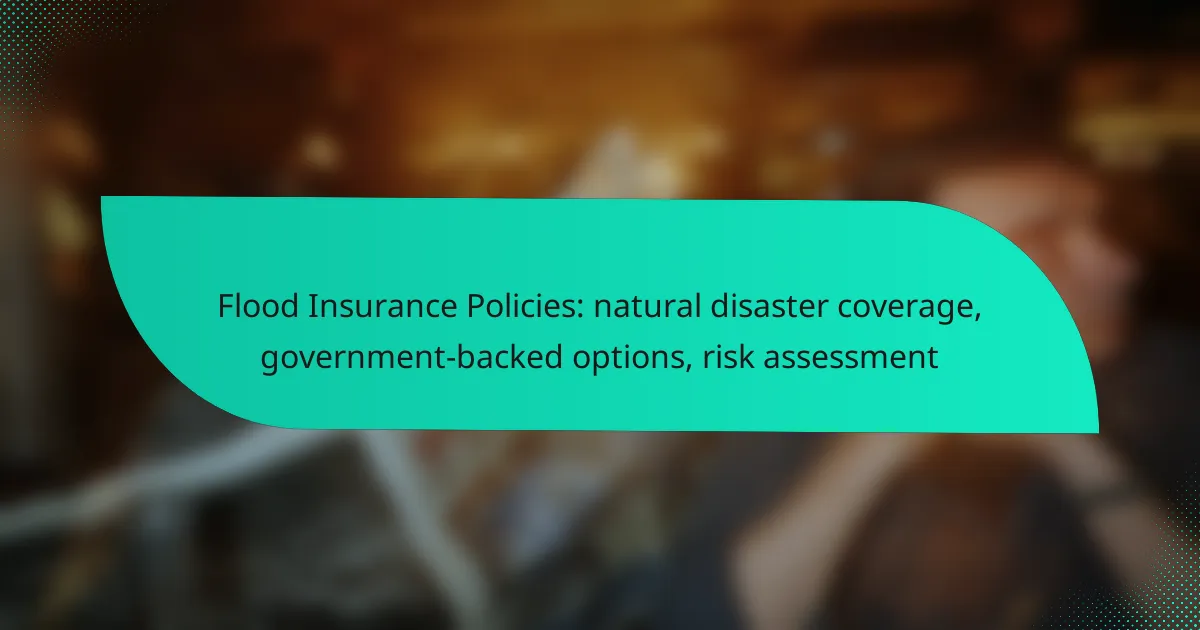Flood insurance is crucial for homeowners in flood-prone areas, offering protection against damages caused by natural disasters. The National Flood Insurance Program (NFIP) and various private insurers provide different coverage options, each with unique features and eligibility criteria. By assessing individual risk factors and understanding how premiums are determined, homeowners can make informed decisions about their flood insurance needs.

What are the best flood insurance policies in the United States?
The best flood insurance policies in the United States typically include options from the National Flood Insurance Program (NFIP), private insurers, and state-specific programs. Each option has distinct features, coverage limits, and eligibility requirements, making it essential to evaluate them based on individual risk factors and local regulations.
National Flood Insurance Program (NFIP)
The NFIP is a federally backed program that provides flood insurance to property owners, renters, and businesses in participating communities. Policies cover both building and contents, with coverage limits generally ranging from $250,000 for structures and $100,000 for personal belongings.
To qualify for NFIP coverage, properties must be located in designated flood zones, and communities must adopt and enforce floodplain management regulations. It’s crucial to understand that NFIP policies typically do not cover damage from moisture, mold, or sewer backups unless specific endorsements are added.
Private flood insurance options
Private flood insurance options have gained popularity as alternatives to NFIP policies, often providing more flexible coverage limits and additional benefits. These policies can cover higher amounts, sometimes exceeding $1 million for structures, and may include coverage for additional living expenses during repairs.
When considering private flood insurance, it’s important to compare quotes from multiple insurers, as premiums can vary significantly based on location, property value, and risk assessment. Additionally, some private policies may offer faster claims processing and broader coverage for specific risks not covered by NFIP.
State-specific flood insurance programs
Some states have developed their own flood insurance programs to complement or enhance coverage options provided by the NFIP. These programs may offer unique benefits tailored to local risks and needs, such as coverage for certain types of properties or additional living expenses during a flood event.
To find out if your state has a specific flood insurance program, check with your state’s insurance department or local emergency management office. Understanding these options can help you make informed decisions about the best flood insurance coverage for your situation.

How do government-backed flood insurance options work?
Government-backed flood insurance options, primarily through the National Flood Insurance Program (NFIP), provide coverage for flood-related damages to property. These policies are designed to make flood insurance more accessible and affordable for homeowners in flood-prone areas.
Eligibility for NFIP coverage
To qualify for NFIP coverage, properties must be located in participating communities that adhere to federal floodplain management regulations. Homeowners must also meet specific criteria, such as the type of structure and its flood risk level, which is assessed based on the property’s flood zone designation.
For example, properties in high-risk flood zones (Zone A or V) typically have different eligibility requirements compared to those in moderate or low-risk zones (Zone B, C, or X). It’s essential to check your community’s participation status and your property’s flood zone classification.
Benefits of government-backed policies
Government-backed flood insurance policies offer several advantages, including lower premiums compared to private insurance options and guaranteed coverage regardless of the property’s risk level. Additionally, these policies often provide more comprehensive coverage for structures and contents.
Another benefit is the availability of federal disaster assistance for policyholders, which can help cover costs not included in standard policies. This can be crucial for homeowners facing significant flood damage.
How to apply for NFIP
Applying for NFIP coverage is straightforward. Homeowners can purchase a policy through an insurance agent who participates in the NFIP program. It’s advisable to gather necessary information, such as property details and flood zone designation, before starting the application process.
Once the application is submitted, there is typically a waiting period of 30 days before coverage takes effect, so it’s wise to apply well in advance of any anticipated flooding. Be sure to review the policy terms carefully to understand the coverage limits and exclusions.

What factors affect flood insurance premiums?
Flood insurance premiums are influenced by various factors, including the property’s location, its characteristics, and the owner’s claims history. Understanding these elements can help homeowners anticipate costs and make informed decisions regarding their coverage.
Location and flood zone classification
The location of a property significantly impacts flood insurance premiums, as areas prone to flooding are classified into different flood zones. Properties in high-risk zones, such as Special Flood Hazard Areas (SFHAs), typically face higher premiums compared to those in moderate or low-risk zones.
Homeowners can check their flood zone classification through the Federal Emergency Management Agency (FEMA) Flood Map Service Center. Being aware of the flood zone can help in assessing risk and determining potential insurance costs.
Property characteristics and risk assessment
Property characteristics, such as the age, elevation, and construction materials, also play a crucial role in determining flood insurance premiums. Homes built on elevated foundations generally qualify for lower rates, while older structures or those made from vulnerable materials may incur higher costs.
Additionally, the presence of flood mitigation features, like sump pumps or flood vents, can positively affect risk assessments and potentially lower premiums. Homeowners should consider investing in such improvements to enhance their property’s resilience against flooding.
Claims history and coverage limits
A homeowner’s claims history can influence flood insurance premiums, as frequent claims may indicate higher risk to insurers. Those with a clean claims record may benefit from lower rates, while those with multiple claims could face increased costs.
Moreover, the coverage limits selected can also affect premiums. Higher coverage limits typically result in increased premiums, so homeowners should carefully evaluate their needs and choose limits that adequately protect their assets without overextending their budget.

What is the process for assessing flood risk?
Assessing flood risk involves evaluating the likelihood of flooding in a specific area and the potential impact on properties and lives. This process typically includes analyzing historical data, geographical features, and current floodplain maps.
FEMA flood maps and their importance
FEMA flood maps, officially known as Flood Insurance Rate Maps (FIRMs), are essential tools for understanding flood risk in the United States. They delineate flood zones, showing areas at high risk of flooding, which is crucial for property owners and insurers.
These maps are used to determine flood insurance requirements and premiums. Properties located in Special Flood Hazard Areas (SFHAs) typically require flood insurance, while those outside may not, impacting financial decisions for homeowners.
How to conduct a flood risk assessment
To conduct a flood risk assessment, start by reviewing FEMA flood maps to identify the flood zone of the property. Next, consider local historical flood data, including past flood events and their severity, to gauge potential risks.
Engaging with local authorities or floodplain managers can provide additional insights into specific risks and mitigation strategies. It’s also beneficial to assess the property’s elevation and drainage systems, as these factors significantly influence flood vulnerability.
Tools for evaluating flood risk
Several tools can aid in evaluating flood risk, including online resources like FEMA’s Flood Map Service Center and various flood risk assessment software. These tools often provide interactive maps and risk calculators that help visualize potential flooding scenarios.
Additionally, local government websites may offer resources and guidelines for conducting assessments. Consulting with flood risk professionals can also enhance the accuracy of your evaluation and provide tailored recommendations based on the specific property and location.

What are the common exclusions in flood insurance policies?
Flood insurance policies typically exclude certain types of damages and limitations that can affect coverage. Understanding these exclusions is essential for policyholders to ensure they have the right protection against flood-related losses.
Types of damages not covered
Flood insurance generally does not cover damages caused by moisture, mold, or mildew that develop over time, even if they are a result of flooding. Additionally, personal property such as vehicles, outdoor equipment, and landscaping are often excluded from coverage. Homeowners should review their policies to identify specific exclusions related to their property.
Limitations on coverage amounts
Most flood insurance policies have limits on the amount they will pay for different types of damages. For example, the National Flood Insurance Program (NFIP) typically caps coverage for residential buildings at around $250,000 and personal property at about $100,000. Homeowners may need to purchase additional coverage or a separate policy for high-value items or structures.
Waiting periods for new policies
New flood insurance policies usually come with a waiting period before coverage begins, often around 30 days. This waiting period is designed to prevent people from purchasing insurance only when a flood is imminent. It is crucial for homeowners in flood-prone areas to secure their policies well in advance of the flood season to avoid gaps in coverage.

How can homeowners reduce flood insurance costs?
Homeowners can reduce flood insurance costs through various strategies, including implementing mitigation measures, bundling insurance policies, and opting for higher deductibles. These approaches can lead to significant savings and better coverage options.
Mitigation measures for properties
Implementing mitigation measures can lower flood insurance premiums by reducing the risk of flood damage. Homeowners should consider elevating their homes, installing flood vents, and using water-resistant materials in flood-prone areas.
Additionally, local governments may offer grants or incentives for homeowners who invest in flood mitigation. It’s advisable to check with local authorities for available programs that can help offset costs.
Bundling insurance policies
Bundling flood insurance with other types of insurance, such as homeowners or auto insurance, can lead to discounts. Many insurance providers offer lower rates for customers who consolidate their policies with them.
When considering bundling, compare the total costs and coverage options across different insurers to ensure you are receiving the best deal. Look for providers that specialize in flood insurance to maximize your savings.
Choosing higher deductibles
Opting for higher deductibles can significantly reduce your flood insurance premiums. A higher deductible means you will pay more out-of-pocket in the event of a claim, but it can lower your monthly or annual costs.
Homeowners should assess their financial situation and risk tolerance before choosing a deductible. It’s often recommended to select a deductible that balances affordability with manageable risk, typically in the range of $1,000 to $5,000.
